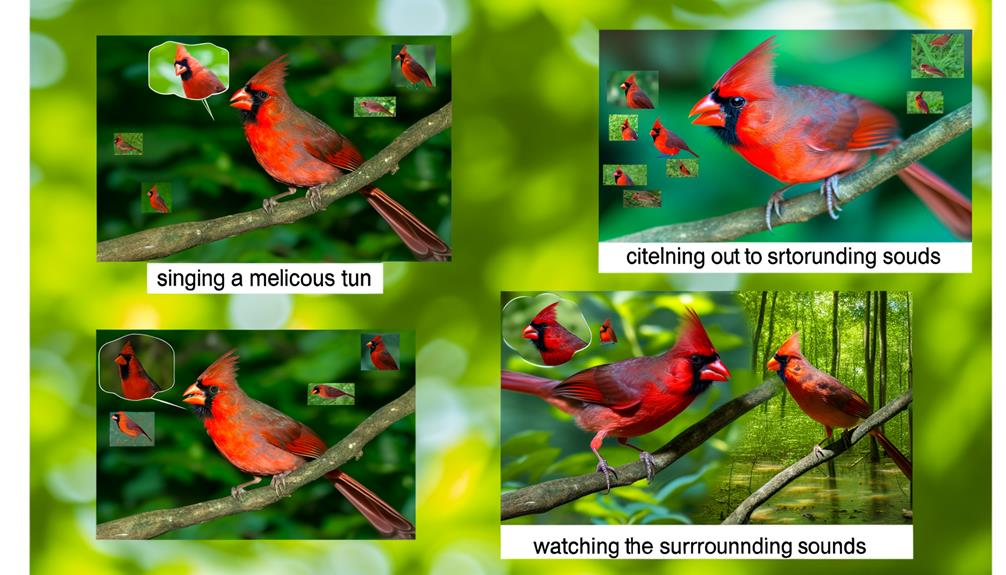Cardinal Calls and What They Mean? A Comprehensive Guide
Cardinal calls are complex vocalizations serving vital purposes. You’ll hear a sharp ‘chip’ when they signal alarm, or a series of high-pitched ‘whistle calls’ for attracting mates.
Foraging is paired with a soft ‘tuk’ sound. When males sing melodious, repetitive whistles, they’re courting females, showcasing genetic quality.
Repetitive and sharp territorial calls warn intruders, often accompanied by physical displays. Alarm calls vary depending on the predator, essential for survival.
Parents use specific calls to guide fledglings, ensuring they learn survival skills. Studying these calls requires spectrogram analysis and field recordings, revealing intricate communication strategies that offer deeper insights.

Key Takeaways
- Cardinals use sharp ‘chip’ calls as alarms to signal predators.
- Mating songs are complex and melodious, indicating genetic quality.
- Territorial calls are sharp, repetitive vocalizations to warn intruders.
- Alarm calls vary based on the threat, with short ‘chips’ indicating immediate danger.
- Urban noise pollution forces cardinals to adapt their call pitch and volume for effective communication.
Cardinal Calls and Their Meanings
| Cardinal Call | Description | Meaning/Purpose |
|---|---|---|
| “Cheer, Cheer” Call | Repetitive, clear whistling sound | Territorial call, used by males to mark their area and warn other birds away. |
| “Pip, Pip” Call | Short, high-pitched notes | A contact call between mates or family members to stay connected. |
| “Chip, Chip” Call | Quick, sharp, chipping sounds | Alarm call used to signal danger or predators nearby. |
| Song | Series of melodic phrases, often louder and varied | Mating call, primarily sung by males to attract females. |
| “Chirp” | Soft, intermittent chirps | Casual communication, often between family members in a calm setting. |
| Aggressive Call | Louder, harsher call combined with body language | Used in confrontations with other birds to assert dominance or defend territory. |
Types of Cardinal Calls
When you listen closely, you’ll notice that cardinals produce a variety of distinct calls, each serving a specific purpose in their communication and behavior.
One common call is the sharp ‘chip’ or ‘cheer’ sound, typically used as an alarm to alert other cardinals to potential danger.
You’ll also hear a series of rapid, high-pitched notes, often called the ‘whistle call,’ which helps maintain contact between mates and flock members.
Another notable call is the softer, repetitive ‘tuk’ sound, which cardinals use during foraging to signal a safe environment.
Each call’s frequency and pattern provide insight into the cardinal’s current activity or emotional state, making their vocalizations a fascinating subject for study and observation.
Mating Songs
Cardinals often break into melodious and complex mating songs to attract potential mates and establish their territory, showcasing both their vocal prowess and fitness. You’ll notice these songs are characterized by a series of clear, repetitive whistles, each varying in pitch and length.
Males primarily perform these songs during breeding season, signaling their readiness and suitability as a mate. The complexity and frequency of a male’s song can indicate his health and genetic quality, as it requires significant energy and coordination. Females are likely to be drawn to the males with the most intricate and vigorous songs.
Territorial Signals
Beyond their mating songs, male cardinals use distinct territorial signals to assert dominance and ward off intruders from their established breeding grounds. When you observe these behaviors, you’ll notice several key actions:
- Vocalizations: Sharp, repetitive calls signal the presence of an intruder and serve as a warning.
- Physical Displays: Fluttering wings and puffing up feathers make them appear larger and more intimidating.
- Perch Defense: Males will aggressively defend their favorite perches, often chasing away other birds.
- Chasing: Swift, direct flights towards intruders act as a significant deterrent.
These signals are essential for maintaining territory and ensuring access to resources such as food and nesting sites. By recognizing these behaviors, you can better understand the complex social dynamics of cardinals.
Alarm Calls
Alarm Calls
How do cardinals communicate imminent danger to one another? Cardinals use alarm calls, which are sharp, high-pitched sounds designed to alert others of predators. These calls are specific and vary according to the type of threat. You’ll often hear a short, metallic “chip” sound, signaling immediate danger. Alarm calls are essential for survival, enabling cardinals to take swift action. The following table summarizes cardinal alarm calls and their corresponding meanings:
| Call Type | Meaning |
|---|---|
| Short “chip” | Immediate predator alert |
| Series of chips | Sustained danger presence |
| High-pitched trill | Aerial predator warning |
| Repeated chirps | Ground predator alert |
| Sharp “tik” | General disturbance |
Understanding these calls allows you to appreciate the complexity and efficiency of cardinal communication.
Communication With Fledglings
When observing cardinal communication with fledglings, you’ll notice parents use specific vocal signals to guide their young. These calls play an important role in teaching fledglings essential survival skills, such as foraging and recognizing predators.
Parent-Child Vocal Signals
In the intricate communication system of cardinals, parent-child vocal signals play a pivotal role in guiding fledglings through their early stages of development.
You’ll notice that these vocalizations are essential for several key behaviors:
- Feeding Calls: Parents emit specific calls to signal feeding times, helping fledglings recognize when food is available.
- Alert Signals: Warning calls are used to alert fledglings to potential dangers, assisting them in learning to respond to threats.
- Location Calls: These calls aid fledglings in locating their parents, promoting a sense of security and cohesion.
- Encouragement Calls: Parents use encouraging calls to motivate fledglings to practice flying and exploring their environment.
These vocal signals support fledglings in developing the necessary skills and behaviors for survival in their natural habitat.
Learning Survival Skills
Cardinals teach fledglings essential survival skills through a series of nuanced vocal interactions that convey critical information about their environment.
You’ll notice that adult cardinals use specific calls to signal the presence of predators, guiding young birds to seek cover. These alarm calls are distinct from those used to indicate food sources.
Fledglings learn to differentiate between these sounds, allowing them to respond appropriately to various threats and opportunities.
Additionally, parents use softer, repetitive calls to guide fledglings during foraging, helping them identify safe and nutritious food.
Seasonal Variations
You’ll notice how cardinal calls change markedly with the seasons, reflecting their adaptive behaviors.
During the breeding season, their vocalizations become more frequent and intricate, aimed at attracting mates and defending territory.
In contrast, winter calls are less elaborate, primarily serving to maintain flock cohesion and signal food sources.
Breeding Season Behaviors
During the breeding season, male cardinals exhibit heightened vocal activity to establish territory and attract mates.
You’ll notice several distinct behaviors linked to their calls:
- Territorial Songs: Males sing loud, melodious songs to mark their territory, deterring other males.
- Mate Attraction: They use specific calls to woo females, showcasing their fitness and genetic quality.
- Duets: Mated pairs often engage in call-and-response duets, reinforcing their bond and coordination.
- Alarm Calls: Sharp, short calls alert mates and offspring to potential dangers, ensuring the family’s safety.
These vocalizations aren’t random; they’re finely tuned to maximize reproductive success. By understanding these behaviors, you gain insight into the complex communication strategies cardinals use during this critical period.
Winter Call Changes
As the breeding season concludes and winter approaches, the vocal patterns of male cardinals shift notably to adapt to the changing environmental demands. You’ll observe a decrease in their territorial songs, which are mainly used to attract mates and ward off rivals.
Instead, cardinals emphasize calls that promote flock cohesion and communication over longer distances. The ‘chip’ call becomes more frequent, serving as a contact call to maintain group integrity and alert others to potential threats. These calls are shorter and less melodious but optimized for penetrating the dense winter foliage and harsh weather conditions.
Understanding these variations helps you appreciate how cardinals dynamically adjust their vocal behavior to ensure survival and effective communication throughout the seasons.
Regional Differences
Regional differences in cardinal calls are influenced by variations in habitat, leading to distinct vocalizations that can be analyzed for ecological and behavioral insights. You’ll find that these differences arise due to:
- Geographical Isolation: Cardinals in isolated regions develop unique calls, enhancing their ability to attract mates and defend territories.
- Habitat Types: Dense forests, open fields, and urban areas each shape call characteristics differently.
- Climate Variations: Temperature and humidity affect sound propagation, influencing call structure and frequency.
- Human Impact: Urban noise pollution forces cardinals to alter call pitch and volume for effective communication.
Studying Cardinal Vocalizations
To study cardinal vocalizations effectively, researchers employ a combination of field recordings, spectrogram analysis, and behavioral observations.
You’ll first need to capture clear audio of the cardinals in their natural habitats, using high-quality microphones.
Once you’ve collected your recordings, analyze them with spectrogram software, which visually represents the frequency, duration, and intensity of each call. This helps identify patterns and variations in the vocalizations.
Complement these findings with behavioral observations, noting the context in which specific calls occur—such as mating, territorial defense, or alarm.
Conclusion
In unraveling the complexity of cardinal calls, you uncover a rich tapestry of communication. Each call, from mating songs to alarm signals, serves a distinct purpose.
You might wonder: Do regional differences influence these calls? Preliminary studies suggest yes, but more research is needed to confirm.
By delving deeper into these vocalizations, you can gain fascinating insights into avian behavior and environmental adaptation.
Keep listening; the truth is out there, waiting to be discovered.






